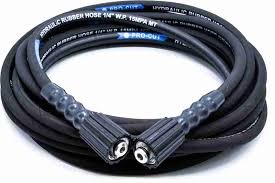A water hose is one of the most essential tools for homes, gardens, farms, and even industrial sites. While it may seem like a simple piece of equipment, choosing the right type of water hose can make a significant difference in convenience, durability, and efficiency.
Whether you’re watering your garden, washing your car, or connecting equipment on a job site, having a quality water hose that matches your needs is crucial. In this comprehensive guide, we’ll break down the types, materials, features, and uses of water hoses to help you make the best choice.
What Is a Water Hose?
A water hose is a flexible tube designed to carry water from a source, such as a faucet or pump, to a desired location. It’s commonly used for irrigation, cleaning, and other water-related tasks. Water hoses are typically made from rubber, PVC, or other synthetic materials, and they come in various lengths, diameters, and pressure ratings.
Types of Water Hoses
There are several types of water hoses available, each designed for specific uses. Understanding the differences can help you choose the most suitable one.
1. Garden Hose
The most common type, a garden hose is used for watering lawns, gardens, and flowerbeds. These hoses are typically lightweight, flexible, and easy to store.
2. Soaker Hose
Designed for efficient watering, soaker hoses allow water to seep through tiny pores along the hose. They’re ideal for garden beds, vegetable patches, and other areas where slow, consistent watering is beneficial.
3. Expandable Hose
Expandable hoses are compact and lightweight when not in use, but they expand up to three times their length when filled with water. They’re great for small spaces and light-duty tasks.
4. Heavy-Duty Hose
These hoses are made with thicker materials and reinforced layers, designed for tough environments and higher water pressure. They’re ideal for commercial or industrial applications.
5. Drinking Water Hose
Used for RVs, boats, or campsites, drinking water hoses are made from non-toxic materials to ensure safe, potable water.
Key Features to Look for in a Water Hose
When choosing a water hose, consider the following features to ensure it meets your requirements:
1. Length
Water hoses come in various lengths, typically ranging from 25 to 100 feet. Choose a length that gives you the flexibility to reach all necessary areas without being excessively long and hard to manage.
2. Diameter
The diameter of the hose affects water flow. Common diameters include:
-
½ inch – Suitable for light-duty watering.
-
⅝ inch – Most common for residential use.
-
¾ inch – Offers higher water flow, ideal for heavy-duty tasks.
3. Material
-
Vinyl: Lightweight and affordable but less durable.
-
Rubber: Durable and flexible, suitable for hot and cold weather.
-
Reinforced: Designed with additional layers for extra strength and kink resistance.
4. Flexibility and Kink Resistance
A good water hose should be easy to maneuver without constantly tangling or kinking. Look for hoses with built-in kink resistance features or reinforced designs.
5. Couplings and Fittings
Fittings are usually made of plastic or metal. Brass fittings are more durable and less prone to leaks. Ensure the fittings are securely attached and fit your water source.
Common Uses of Water Hoses
1. Gardening
A water hose is indispensable for maintaining a healthy garden. From watering plants to cleaning garden tools and patios, a hose simplifies daily tasks.
2. Car Washing
Washing your vehicle at home becomes easier and more efficient with a high-pressure water hose. Attach a spray nozzle for better control.
3. Lawn Maintenance
Watering the lawn evenly is crucial for lush, green grass. Using a sprinkler attached to a water hose makes the job effortless.
4. Cleaning
Driveways, sidewalks, walls, and even outdoor furniture can be cleaned effectively with a hose and a suitable spray attachment.
5. Construction and Industrial Use
On construction sites, a durable water hose can be used for cleaning tools, mixing concrete, or connecting to machinery that requires water.
How to Maintain Your Water Hose
To get the most life out of your water hose, proper care and storage are essential.
1. Drain After Use
Always drain water from the hose after use to prevent mold growth and freezing damage in cold weather.
2. Store Properly
Keep your hose coiled neatly and stored in a shaded area or a hose reel. Avoid leaving it in direct sunlight, which can degrade the material over time.
3. Avoid Sharp Bends
Avoid kinks and sharp bends, as these can weaken the structure and cause leaks or splits.
4. Check for Leaks
Regularly inspect the hose for leaks, cracks, or worn fittings. Replacing a faulty connector or using repair tape can extend its life.
Tips for Buying the Right Water Hose
-
Identify Your Needs: Determine the primary purpose – gardening, cleaning, or industrial use.
-
Consider Your Water Source: Ensure the hose fits your spigot or faucet type.
-
Choose the Right Length and Diameter: Buy the length that reaches all areas you plan to water, and select a diameter based on flow needs.
-
Check Durability: For frequent use, opt for reinforced or rubber hoses for better longevity.
-
Test Before Use: When buying from a store, ask if you can test the flexibility and fittings before purchasing.
Environmental Considerations
Some water hoses contain materials that can leach harmful chemicals into the soil or water. If you’re watering vegetables or fruits, consider a hose labeled as lead-free and safe for drinking water. This ensures that your food is not contaminated during irrigation.
Conclusion
A water hose may seem like a simple tool, but the right one can significantly enhance your efficiency, reduce frustration, and last for years. Whether you’re a home gardener, a DIY enthusiast, or managing a larger space, understanding the various types and features of water hoses allows you to make a smart investment.
From choosing the right length and diameter to ensuring proper storage and maintenance, every detail matters. With the right water hose, your daily outdoor chores become easier, cleaner, and more enjoyable.



